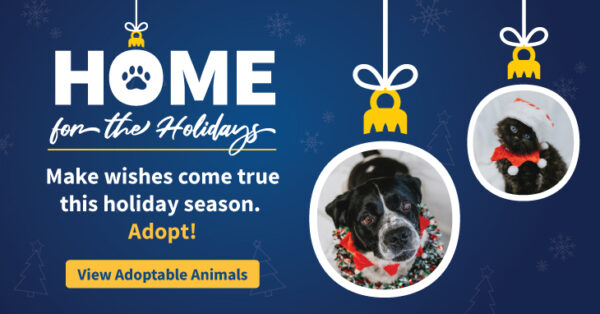Tips for a successful adoption
by Ontario SPCA and Humane Society | Pet Planning | December 5, 2025

Dogs are exceptional animals, and their ability and desire to form deep and loving bonds with humans is extraordinary. By adopting, you are truly giving your dog an amazing gift – a second chance.
Following an adoption, it may take a few weeks or months for you and your dog to fully adjust to your new life together, and to establish a relationship based on mutual understanding, trust and respect. Be patient. Remember, there is a reason you’ve chosen this dog, or they have chosen you!
The following adoption tips will help you bring out your dog’s superstar qualities.
Help your dog relax at home alone
Adopted dogs usually form deep bonds with their new parents, and in the beginning, separation may be emotional for you both. Help give your dog the confidence to be home alone by incorporating the following confidence-building tips into their day. Begin using these tips as soon as you bring your new friend home.
- Leave the house frequently for short periods by walking out the door, closing it, and then returning. Once your dog is comfortable with short departures, randomly include some longer departures.
- Ignore your dog during departures and arrivals (be very casual – don’t look back!).
- Practice mini departures inside by closing doors when you take a shower, use the bathroom, etc.
- Studies have shown that dogs are calmed by classical music so consider changing your radio station.
- Try to stay relaxed (if you’re anxious your dog’s anxiety will increase).
- Give your dog a safe chew toy stuffed with treats before you leave the house.
A dog with severe separation anxiety may destroy property, bark incessantly, scratch around doors or windows, or injure themselves in a frenzied panic. Speak to a dog trainer, animal behaviourist or veterinarian for ways to increase your dog’s comfort when they are home alone. Learn more about separation anxiety.
Establish household rules and routines
If your dog is living with more than one person, it is especially important that rules and routines are followed by every member of the household
to encourage consistency, and to give your dog stability and leadership. The more consistent your family is, the quicker your dog can figure things out.
Lack of routine, yelling at your dog for doing things wrong, or letting them make up their own rules will only make your dog anxious and unsettled. Consider incorporating some of the following rules and routines into your household.
- Feed your dog high-quality meals on a regular schedule in a quiet place.
- Offer your dog plenty of enrichment throughout the day, such as going for walks. Active dogs may also require vigorous off-leash exercise in a secure area.
- Until your dog is housetrained, sleeping in a crate in someone’s bedroom is recommended. Once they can hold it all night, they can graduate to sleeping on their own.
- Use treats as rewards for good behaviour (such as lying down quietly), or as training aids. Do not feed your dog from the table or when they are whining, barking or pawing you.
- Teach your dog that they must ask for things by sitting politely, rather than by making demands (e.g. barking/pawing). Before giving them the things they value, such as meals, wait for them to sit. Turn away if they start barking and/or jumping.
Take a dog training class
Taking your dog – and your family – to dog training classes is a wonderful and fun way to help you understand how your dog thinks and learns, and how to motivate him or her to repeat behaviours you like!
You can also have a trainer visit your home for private sessions. While costs vary, the investment will repay itself many times over throughout the life of your dog. A good class can put you in a room full of other new dog parents just like yourself, answer all your day-to-day questions, and help address the minor issues that may arise.
Look for a trainer that uses “positive-reinforcement” techniques that are humane and fun, including “lure-rewarding” (using treats to lure dogs into position), and “clicker training” (marking the exact moment the dog is doing the desired behaviour using a small device that makes a “click” – followed by feeding a treat).
Learn more about positive reinforcement training.
Check out our blog for more training tips.
With these tips in mind, we hope you enjoy the journey of welcoming a new furry family member into your home!
If this information was helpful, please help us continue to educate about pet health and well-being by making a donation. As a registered charity that does not receive annual government funding, the Ontario SPCA and Humane Society depends on the generosity of donors to change the lives of animals in need.
Categories
Testimonial
I stand behind SPCA with my monthly gift
I stand behind SPCA with my monthly gift. I am so happy there are folks like you to care for those who can’t help themselves. My family and I have had animals all our lives and know what a comfort they are. Thank you SPCA.
